Philips Cinema 21:9 58PFL9955H/12 Review
Philips Cinema 21:9 58PFL9955H/12
This 58in widescreen telly is one of the best LED LCD TVs we've ever reviewed.
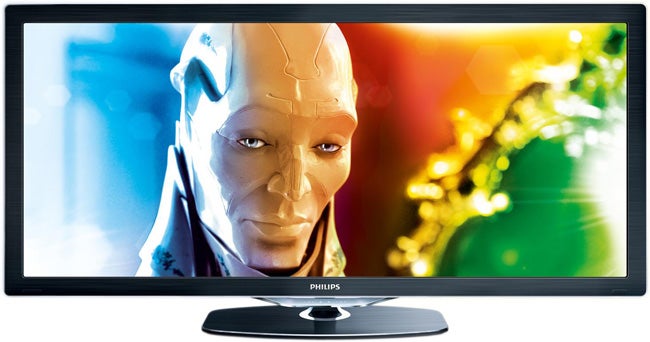
Verdict
Pros
- Vibrant and well saturated colours
- Excellent sound quality
- Amazing picture quality
Cons
- No Freeview HD tuner
- Crosstalk with 3D
- Slight haloing during off-axis viewing
Key Specifications
- Review Price: £3999.00
- 4 HDMI slots
- HD and 3D ready
- Built-in Wi-Fi
- Two SCARTs (both RGB)
- 21:9 movie aspect ratio
The problem with widescreen TVs is simply that they’re not wide enough. Or at least, they’re not wide enough to truly satisfy your average movie addict.
The reason for this will be abundantly apparent to anyone who’s ever been annoyed to see black bars above and below pictures on a DVD or Blu-ray. The simple fact is that the majority of films made for a cinema release are shot using a wider aspect ratio than the 16:9 ratio of your widescreen TV. Instead they favour a ratio around 2.35:1 that requires the dreaded black ‘letterbox’ bars when they’re shown on even a widescreen TV.
Cue the Philips 58PFL9955H. For this is Philips’ new ‘Cinema 21:9’ telly, built to deliver an aspect ratio that works out at around 2.39:1 in movie width terms. So it can show all those lovely super-wide films without the need for black bars – check it out in action in our IFA 2010 First Look report, complete with video.
There is a catch with this that we should clear up right away, though. Namely that unfortunately, although the Blu-ray spec supports the encoding of full 2.35:1 film transfers that could map perfectly to every single one of the 2560×1080 pixels built into the 58PFL9955H’s 58in screen, no Blu-ray disc has yet used the option. Instead, black bars are placed above and below pictures at the mastering stage for 16:9 TVs, making them part of the picture that gets sent to your TV.
The 58PFL9955H thus has to use processing to ‘blow up’ the incoming 2.35:1-ratio sources so that the built-in black bars are pushed off the edges of the screen. This means interpolating pixels into the picture to fill the space that would have been occupied by the black bars. But it also means manipulating the image’s geometry at its left and right edges, for otherwise the process of magnifying the picture would also push the left and right sides of the original picture off the screen.
Normally we’d be highly suspicious of such tinkering with pictures — and we’d definitely be much happier if there were some ‘real’ 21:9 Blu-ray transfers for the 58PFL9955H to work with. But the quality of Philips’ aspect ratio processing and the sheer pleasure in seeing ultra-wide films appearing without black bars instantly allays our ‘purist’ concerns.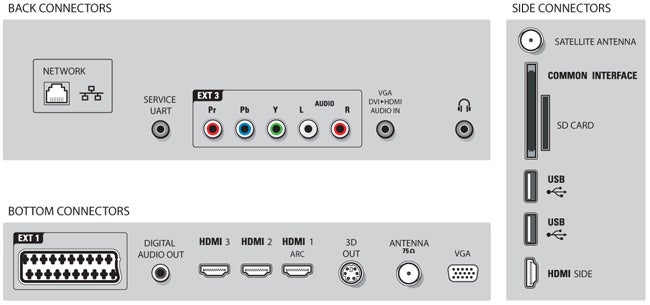
Before we go into more detail on the unparalleled experience of watching the 58PFL9955H, though, we’ve lots of other interesting things to talk about. Kicking off with the set’s truly lovely design. It catches the eye right away, obviously, thanks to its extreme width. But also very lovely is the brushed aluminium black bezel – a big improvement over the black plastic sported by Philips’ original, 56in Cinema 21:9 set launched last year.
This being a Philips TV, the 58PFL9955H’s design additionally benefits from Ambilight, where coloured light capable of matching — to a startlingly local degree — the image content is emitted from the TV’s edges. Happily this light comes from the TV’s top edge as well as its left and right edges, so the Ambilight effect doesn’t lose cohesion despite the TV’s extreme width.
More mundane but still mighty useful are the 58PFL9955H’s connections. These include four HDMIs (one built to the v1.4 spec for 3D), a USB port, an SD card slot, and an Ethernet port. Plus the set sports built in Wi-Fi – a cool trick we wish more TVs offered.
As you’d expect from such a connections array, the set’s multimedia talents are extensive, including playback of a multitude of video, photo and music file formats from USB stick or networked PC, and access to Philips’ online Net TV service.
We’ve covered Net TV in depth in previous Philips reviews and our recent feature focusing on the different TV online services, so all we’ll say here is that its highlight is a built-in Opera browser that lets you surf the Web at large rather than restricting you to Philips’ ring-fenced content.
We also won’t trouble you by going into detail about the set’s extremely powerful Perfect Pixel HD video processing engine, as again, we’ve covered this extensively before. Suffice it to say that it’s arguably the only picture processing engine in the mainstream TV world that might be expected to comfortably handle the challenges associated with optimising non-21:9 sources for a 21:9-shaped screen.
D glasses for Philips Cinema 21:9 TV.” width=”300″ height=”180″ class=”align size-medium wp-image-199294″ srcset=”https://www.trustedreviews.com/wp-content/uploads/sites/54/2010/11/14476-philips58pfl99553-1.jpg 600w, https://www.trustedreviews.com/wp-content/uploads/sites/54/2010/11/14476-philips58pfl99553-1-300×180.jpg 300w, https://www.trustedreviews.com/wp-content/uploads/sites/54/2010/11/14476-philips58pfl99553-1-320×192.jpg 320w” sizes=”(max-width: 300px) 100vw, 300px” />
What we certainly do want to talk about, though, is the 58PFL9955H’s 3D readiness. In fact, unlike other 3D Philips sets, this one actually has the transmitter built into the TV’s body. Plus you get two pairs of active shutter glasses thrown in for free, compared with just one with some other manufacturers. Note that there’s no 2D to 3D conversion, though.
Also important to mention in the features section is the lighting technology driving the screen. For not only does it use a direct LED illumination array with contrast-boosting local dimming, but it also adds around a third more individually controllable LED clusters than the 224 found in the brand’s outstanding PFL9705 models.
With so much going on in the features department with the 58PFL9955H, it’s rather surprising that it doesn’t have a built-in Freeview HD tuner. But there you go. You’ll just have to stick with the Sky HD or Virgin box you’ve probably got anyway if you’re considering spending £4k on a TV.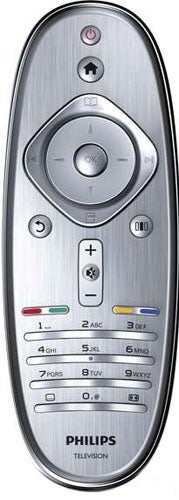
Fed a trusty 2.35:1-ratio favourite, Casino Royale on Blu-ray, the 58PFL9955H immediately generates an almost visceral response from all who behold it. And by visceral, we actually mean jaw-dropping and eye-popping!
For a start, there’s just something wonderfully right about the 21:9 shape when applied to a TV. Its extra width chimes more naturally with the way our eyes perceive the world, and so it feels both more relaxing than a normal 16:9 picture and, more importantly, more immersive.
It’s also superb not to have black bars above and below the Casino Royale picture. We’ve watched this Blu-ray dozens times, but we’ve never felt so completely engaged by it as we were on the 58PFL9955H – a fact we’re convinced not having the black bars is at least partly responsible for.
Once you’ve got past the sheer wonderment of seeing films bar-free and stretched so wide in your living room, it also hits you that the quality of the images on show is pretty extraordinary. As with the PFL9705H range, for instance, the 58PFL9955H’s black level response is ridiculously good, comfortably outgunning all other LCD TVs we can think of, and even pushing the best plasma TVs hard.
What’s even more amazing about the58PFL9955H’s truly profound black levels is that they can co-exist in the same frame as emphatically bright and intense peak whites and rich colours. The local dimming aspect of the LED lighting array means the set doesn’t have to reduce overall brightness levels when showing dark material, and there really is no over-stressing just how strong an effect this has on the image’s general dynamism – and the believability and watchability of dark scenes in particular.
You perhaps get a touch less shadow detail in the darkest corners than you might with a top plasma set, but we doubt you’ll notice. Especially as you’ll be so busy lapping up so many other things about the picture quality.
Including its colours. For as with the PFL9705 series, the 58PFL9955H’s colours are stunningly vibrant and well saturated. Yet crucially, this intensity hasn’t come at the expense of either tonal naturalism or subtlety. In fact, the sense of ‘flatness’ that can sometimes accompany very intense colours is nowhere to be seen.
The 58PFL9955H’s sharpness with both HD and standard definition sources is also terrific – especially as the set suffers hardly at all with motion blur, and can have all judder removed with startling efficiency by the set’s Perfect Natural Motion circuitry.
The sharpness achievable with standard definition is nothing short of revelatory, in fact, as the set’s video processing engine adds almost HD levels of detail at the same time as stretching pictures to fill the 21:9 frame (if you wish), all without exaggerating source noise.
In short, watching all sorts of 2D stuff on the 58PFL9955H was quite possibly the most fun we’ve ever had reviewing a TV. Honestly. It’s just impossible to describe just how effective and impactful the 21:9 shape is, especially when it’s combined with the stunning picture quality Philips has got from its 2010 direct LED sets.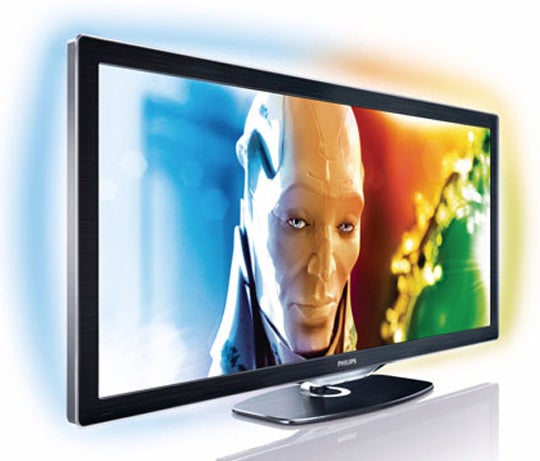
The only problems we had with 2D viewing were some slight haloing during off-axis viewing, and the typical Philips situation whereby you need to be very careful indeed with the set’s video processing. Get the set up wrong, and you can end up with softness, noise and processing artefacts. But believe us: the motivation to learn how to get things looking right is mighty high once you’ve seen what the set is capable of.
3D viewing is a touch more problematic, on account of that old 3D chestnut, crosstalk (double ghosting) noise. For the 58PFL9955H definitely suffers more with it than any 3D plasmas, especially those from Panasonic.
However, it actually suffers less with crosstalk than any other brand of LCD 3D TV, in that while it’s there, it looks fainter and less overwhelming. This leaves you freer to appreciate the many good things about the 58PFL9955H’s 3D pictures, such as startling brightness levels and colour saturations by active shutter 3D standards, and high levels of detail.
It also must be said that the 21:9 shape of the TV works great with 3D, with the extra width and impressive screen size making it easier to get lost in the 3D world you’re watching. Especially if you turn off the Ambilight feature, which oddly seemed rather distracting with 3D sources.
So engrossed were we by the 58PFL9955H’s pictures that we almost forgot to pay attention to the set’s audio. Which would have been a major oversight as it happens, since it’s one of the best sound performers around thanks to a combination of raw power and its ability to deliver genuine extremes of bass and treble rather than leaving everything crammed into the mid range like most flat TVs do.
Verdict
Sure, the 58PFL9955H’s lack of a Freeview HD tuner is irritating, the work needed to get the best from it might seem intimidating, and the crosstalk with 3D (however minimal versus rival LCD sets) is definitely an area for Philips to work on for next time. But ultimately during our time with the 58PFL9955H there were moments – many moments, actually – where it genuinely feels like the best TV we’ve ever reviewed. And it’s this feeling that’s stayed with us far, far more since we reluctantly had to give the TV back than any of the negative stuff.
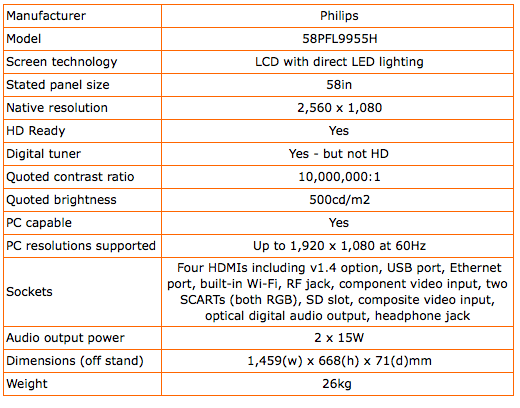
How we test televisions
We test every TV we review thoroughly over an extended period of time. We use industry standard tests to compare features properly. We’ll always tell you what we find. We never, ever, accept money to review a product.
Trusted Score
Score in detail
-
Features 9
-
3D Quality 8
-
Value 8
-
Design 10
-
2D Quality 10
-
Sound Quality 9
Features
| Size (Inch) | 58in |
| Display Type | LED |

